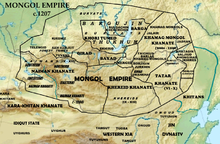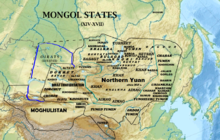 Mongol Empire c. 1207, Uriankhai and their neighbours | |
| Regions with significant populations | |
|---|---|
| 26,654 (2010 census)[1] | |
| Languages | |
| Oirat, Mongolian | |
| Religion | |
| Buddhism, Mongolian shamanism, Atheism | |
| Related ethnic groups | |
| Mongols, especially Oirats | |




Uriankhai /ˈʊriənxaɪ/[a] is a term of address applied by the Mongols to a group of forest peoples of the North, who include the Turkic-speaking Tuvans and Yakuts, while sometimes it is also applied to the Mongolian-speaking Altai Uriankhai. The Uriankhai included the western forest Uriankhai tribe and the Transbaikal Uriankhai tribe, with the former recorded in Chinese sources as Chinese: 兀良哈; pinyin: Wùliánghā). It is also the origin of the Korean term "olangkae", 오랑캐, meaning barbarian.
Cite error: There are <ref group=lower-alpha> tags or {{efn}} templates on this page, but the references will not show without a {{reflist|group=lower-alpha}} template or {{notelist}} template (see the help page).